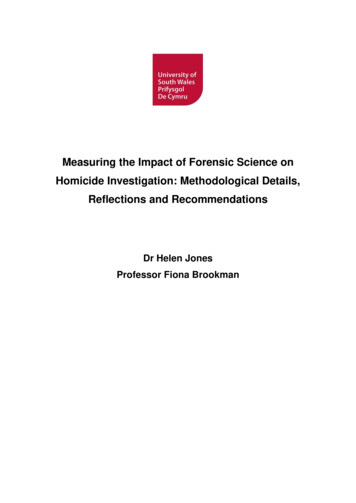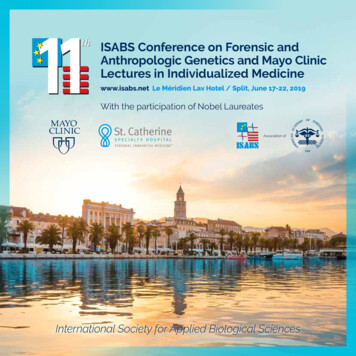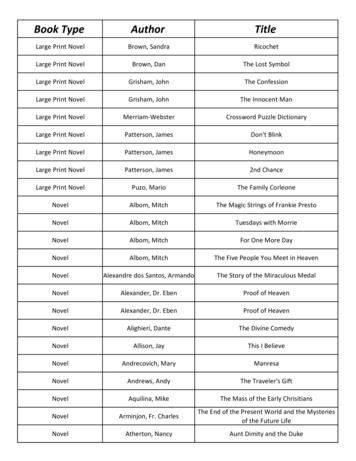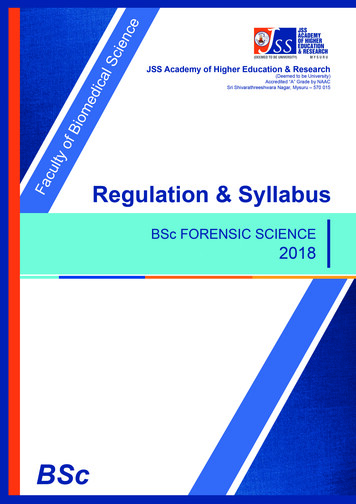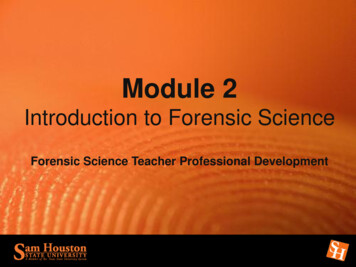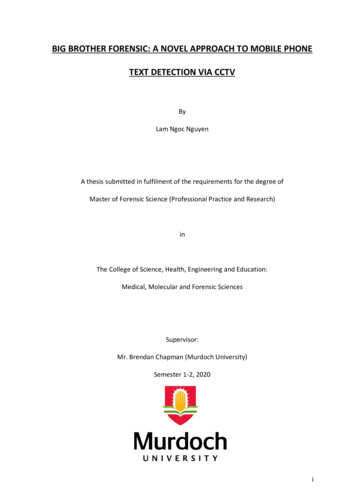
Transcription
BIG BROTHER FORENSIC: A NOVEL APPROACH TO MOBILE PHONETEXT DETECTION VIA CCTVByLam Ngoc NguyenA thesis submitted in fulfilment of the requirements for the degree ofMaster of Forensic Science (Professional Practice and Research)inThe College of Science, Health, Engineering and Education:Medical, Molecular and Forensic SciencesSupervisor:Mr. Brendan Chapman (Murdoch University)Semester 1-2, 2020i
DeclarationI declare that this manuscript does not contain any material submitted previously for theaward of any other degree or diploma at any university or other tertiary institution.Furthermore, to the best of my knowledge, it does not contain any material previouslypublished or written by another individual, expect where due references have been madein the text. Finally, I declare that all reported experimentations performed in this researchwere carried out by myself, except that any contribution by others, with whom I haveworked is explicitly acknowledged.Signed: Lam Ngoc NguyenDate: 18/12/2020ii
AcknowledgementsI would like to offer my most sincere gratefulness to Mr. Brendan Chapman – a man of wits,wisdom, kindness and patience. This project would not become a possibility had I not methim.Secondly, to my family, friends, my UWA Kendo club, as well as Brendan’s team for justbeing presence in my life.Thirdly, I'd like to give a special mention to Miss Brooke Judson, Mr. Ryan Longridge, Mr.Ben Thompson, Miss Elaine How, and Miss Grace Mulder. Each of them has given me atremendous (but much needed) support for this project, ranging from helping with editingmy grammar, to helping me by illustrating a diagram to prove a point.Last but not least, I would like to send my deepest gratitude to Murdoch University forproviding the resources and testing facility for this project.Thank you for believing in me! I made it!iii
Table of contentsTitle Page . iDeclaration . iiAcknowledgements . iiiPart OneLiterature Review. 1-59Part TwoManuscript . 61-146iv
Part OneLiterature ReviewMOBILE PHONE MONITORING: APPLICATION OF CLOSED-CIRCUITTELEVISION IN FORENSIC AND FUTURE DIRECTIONS1
Table of ContentsLiterature Review1List of Figures3List of Tables4List of Abbreviations5Abstract61.Introduction72.The usage of CCTV11Current usage11a)i.ii.b)c)i.ii.3.Proactive surveillanceReactive surveillanceHow practical is the monitoring purpose?14Limitation(s)17Factors related to the cameraHuman factorPrevalence of mobile phone in digital forensic dataa)Mobile phone in digital forensici.ii.iii.4.1112Growth of mobile phone submitted as evidenceType of data can be extracted from a mobile phoneLimitation in mobile phone forensic digital analysisApplication of CCTV on a mobile phone screen monitoring1820242425303236a)Project aim37b)Experimental design375.Future research - Coupling technique38a)Tracking and detection39b)OCR for automated text extraction396.Conclusion477.References482
List of FiguresFigure 1. The number of mobile devices submitted as an exhibit associates with the type ofcrime between 2005- 2008 in South Australia, adapted from Turnbull et al. (2009).Figure 2. The number of mobile phones submitted as evidence for drug, fraud, andpornography for the period between 2004 -2008 in South Australia, adapted from Turnbullet al. (2009).Figure 1. SAPOL ECS - devices presented for analysis per year (2004 – 2015), adapted fromQuick and Choo (2017).Figure 4. The proposed decision tree for an automated text mining from a CCTV footagecapturing a phone screen. Note that the ‘Refeeding’ dash line refers to the teaching processwhereby the user’s decision is being used to teach the machine the context of the chosenwords so the next time they can do an automated detection if the same word appears in asimilar context. The arrows represent the steps the machine will follow.3
List of TablesTable 1. The number of mobile devices submitted as an exhibit associates with the type ofcrime between 2005- 2008 in South Australia, adapted from Turnbull et al. (2009).Table 2. The number of mobile phones submitted as evidence for drug, fraud, andpornography for the period between 2004 -2008 in South Australia, adapted from Turnbullet al. (2009).Table 3. Data from SAPOL ECS from 2004 -2015 for the number of mobile phones submittedfor analysis, adapted from Quick and Choo (2017).4
List of AbbreviationsAbbreviationDefinitionCCTVClosed Circuit TelevisionAFPAustralian Federal PoliceDVIDisaster Victim IdentificationFPSFrame rate Per SecondPDAPersonal Digital AssistantSAPOLSouth Australia PoliceECSElectronic Crime SectionSMSShort Message ServiceMMSMultimedia Messaging ServiceNCMECNational Centre for Missing and Exploited ChildrenMDMMobile Communications DataYOLOYou Only Look OneOCROptical Character RecognitionAPPsAustralia Privacy Principles guidelines5
AbstractA review was undertaken for the usage of Closed-Circuit Television (CCTV) in relation tocrime investigation, detection and prevention. The aim of this paper is to discuss the usageof the current CCTV system, and how effective it is concerning crime deterrence and crimeprevention in aid of national security. Similarly, the current usage of mobile phones and itsprevalence as a tool for committing crime, as well as the current limitations in digitalforensics involving mobile phone extraction and analysis were also addressed. Furthermore,this review aims to highlight the current potential for a coupling technique betweenartificial intelligence and CCTV footage to maximise the extraction of mobile phone screencontent.6
1. IntroductionClosed-Circuit Television (CCTV) usage has become ubiquitous in the last few decades. Theyhave a wide range of uses which are beneficial to security, both in the public and the privatedomains (1,2). Currently, CCTV is being utilised for four purposes. Firstly, CCTV is used as acrime deterrence tool (1,3). If a perpetrator perceives CCTV as a risk for getting caught, itspresence will effectively discourage any potential offender (4). Secondly, CCTV is used as acrime detection tool (5,6). The purpose of an early detection is to help with the earlyallocation of the first responder to the target areas, which is thought to control theescalation of violence (3,7). CCTV may increase the chance of being apprehended andprosecuted, discouraging offenders from committing a crime (8). Thirdly, with all theperceived effectiveness of CCTV presented above, it creates a psychological effect ofreducing the fear of crime while increasing the perceived safety among the public (3,8,9).Last but not least, CCTV is being implemented as a site management tool to help theoperator effectively monitor the traffic within a controlled access location (such as at acarpark or at entrance and exit points) (9,10).As technology continues to evolve, the prevalence of mobile phone usage as a tool toorchestrate or to commit crime is also increasing (11–13). In the Boston Marathon bombingin 2013, NBC News reported a large finding of digital evidence from the defendant’s mobiledevices, which includes phone, computer and other devices (14). Text message retrievedfrom the phone of the offender’s friend shows there was a correspondence between themprior to, and after the attack (14). The nature of the message indicates they had an insideknowledge regarding the event (14).7
On top of the physical evidence seized from the perpetrator in the Boston bombing case,CNN also reported many cell phones and cameras were stationary around Boston streets,meaning there is a possibility that many photos or footage had been captured by thebystander (15). There were nearly 600 CCTV within the vicinity of the attack, and morecameras from the public transport system, such as at the train station, or on the bus ortrain (15). If authorities were to obtain this evidence in real time, it could provide a wealthof knowledge detailing a rough timeline leading up to the bombing event to interpret andprevent future tragedies.Despite the exploitation of mobile phone highlighted above, mobile phone can also be usedfor a good purpose to combat crime. In June 2011, the Vancouver Canucks lost to theBoston Bruins in the Stanley Cup finals inciting riots across the city of Vancouver (15). Thisriot prompted the Vancouver police to establish a mass video collection server to allow thepublic to anonymously send in any video footage and photos recorded on their phone orcamera for investigative purposes. In response, the public sent in over 5000 hours’ worthof video evidence to be used in helping the investigation (15).While mobile devices play an important role in crime, from being used as a device forplotting bad deeds to being used to combat it; in the current academic literature, there islittle coverage on the misuse of mobile phone for such purposes. As criminals change theirtactics, law enforcement have to think of a way to come up with preventive measurementaccordingly.8
As mobile phone contains a lot of private information, mobile users are becoming moreprotective of their personal data. Messaging services that can offer an end-to-end userencryption are preferrable over the standard text messaging services (16,17). Having saidthat, users are often operate their phone in plain view of the public. According to theMobile Consumer Survey 2016, 45% of those surveyed use a smartphone while using publictransport (18). Meanwhile, 41% use it while out shopping, and 31% use it while walking(18). In addition, studies have shown that increasing the amount of cognitively taxingactivities performed on the phone would decrease the participant’s awareness to thesurrounding, as they relied more on the central vision to recognise activities around them(18,19). These statistics and findings show that there exists a window of opportunity tomonitor and collect data via CCTV.The task of monitoring personal screen device using CCTV is an ambitious cross-overbetween multidisciplinary, including security, law, forensic and digital forensic. However,such monitoring task can raise questions regarding the law that govern the privacy of themobile user. According to Australia Privacy Principles guidelines (APPs) (2019), it is,however, not illegal to record and collect sensitive information to lessening or preventinga serious threat to life, health or safety (19). The act of collecting personal information isjustified when it is ‘unreasonable or impractical to obtain the individuals consent’ and if itis ‘necessary to lessen or prevent a serious threat to the life, health or safety or anyindividual, or to public health or safety’ (19). Examples were given to case such as suspicionof child abuse, of planning or conducting unlawful activity that could threaten nationalsecurity (19). In fact, this is quite a common practice in countries (such as the United States)to intercept communications that provide information for investigation, predict and9
prosecute acts of terrorism (20). Therefore, one could argue that in high-risk area such asthe airport, it is justified to monitor personal mobile device(s) in the act of counterterrorismand crime prevention.This paper presents a novel approach to the detection and extraction of the content onuser mobile phone screens. Having the advantage of screening the phone screen would behighly beneficial for national security to combat not only terrorism, but also everyday illegalacts that threaten the infrastructure of the country. Currently, there is no framework toguide how CCTV needs to be configured to support the task of screen monitoring on apersonal mobile device. The intention of this research is, therefore, creating that basis. Inorder to do that, it is crucial to understand where the current problems lie.There are three aims associated with the review: (i) address the current usage of CCTV, itseffectiveness and its limitation, (ii) the prevalence of mobile phone in crime, and thecurrent problems in digital forensic surrounding processing a mobile phone, and (iii) thepotential future application of CCTV and digital forensic while coupling with othertechniques to maximise data extraction and moving towards a framework of designing anautomated surveillance system to serve such purposes.10
2. The usage of CCTVa) Current usagei.Proactive surveillanceThe most common CCTV system is used for public safety concerns, and it often involvesreal-time surveillance to look out for cues leading up to potentially significant events (5,6).This type of surveillance is also known as ‘proactive surveillance’ (21). The aim of proactivesurveillance is for prevention of situational crime and disorder through the deterrenceeffect (22).Situational crimes are crimes that being committed intentionally, mainly when theperceived reward for criminal opportunities outweighed the perceived risks of detection(23). The idea of situation crimes is similar to the ‘Routine Activity Theory’ proposed byCohen and Felson (1979), which suggested that in order for a crime to occur, threerequirements must be met: a motivated offender, a suitable target, and a lack of a capableguardian (4). In that sense, any acts that could disrupt the flow of these requirements canprevent a crime from happening. For example, one can reduce the number of opportunitiesfor crime to occur by increase the potential risk of detection through modified the physicalenvironment (e.g. installing more CCTV cameras) to prevent situational crimes fromoccurring (24).As part of a crime intervention strategy, CCTV is thought to provide the public with morereassurance and present less risk of victimisation, which in turn will encourage more publicaccess to the area (3,8,9). With more public access, it is naturally expected that the naturalsurveillance would also increase, meaning the perceived risk of being caught will be higher11
(8). As a result, the rate of crime is expected to be reduced. Therefore, with the CCTVpresence at the scene, it is argued that CCTV aids in crime deterrence, as it increases thechance of crime detection (1,3).CCTV is further used as a site management tool (9). The footage can help to observe trafficpatterns, or for crowd control at crowded space. The idea is to promote an effectivedeployment of security staff or police officers to the area of concerns where suspiciousbehaviour is occurring (3,7). An example includes using CCTV as a means of controllingalcohol-related behaviour (such as break up a brawl at a pub), to monitor anti-socialbehaviour or to disperse large groups of individuals (such as on-street traders, or beggars)(9). CCTV is also being used to maintain the order of the public. CCTV is exceptionally usefulfor traffic monitoring and analysis to assist with speed control, vehicle counting, automaticplate recognition and incident analysis (25,26). CCTV footage may also be presented asevidence in court (9). The images derived from CCTV footages can incriminate or exoneratea person of interest from further enquiries. Similarly, CCTV footage can be used to securean early guilty plea from offenders (27).ii.Reactive surveillanceOn top of the current usage for CCTV highlighted in the previous section, CCTV footage canalso be used for crime detection, even after an event has occurred. This type of surveillanceis referred to as a ‘reactive CCTV surveillance’, or ‘post-event analysis’ , where theoperators reviewed the recorded footage after an event has occurred (2,28–30). Althoughwe cannot change what has happened once the crime has took place, however, having the12
ability to conduct a post-event analysis would be a great tool to learn to detect thesebehaviours in the future to prevent future tragedies (31).By tracking the movement of objects and/or person of interest throughout the scene,crucial information regarding the person of interest can be learned. This information canrange from the person’s behaviours, reactions, interactions, and the relative relationshipbetween the person of interest and the object of interest (25). For example, CCTV streetsurveillance is typically used to aid investigation by identifying anti-social behaviours,monitoring and tracking movement in relation to drug or to help identify a missing person(25,32–34).Additionally, when working with the aftermaths, the emphasis of the investigation is notonly focus on the perpetrator(s), but it is also focus on the victim(s). For example, when alarge number of people are killed in a terrorist attack, it can take a long time to accuratelyidentify the victims (35). According to the Australian Federal Police (AFP), depending on thenumber of victims involved, it may take days or even weeks to recover all the deceasedfrom a mass fatality site (36). These scenes can be chaotic and dangerous, which canprevent the Disaster Victim Identification (DVI) officers from entering until several daysafter the occurrence. On top of that, DVI officers must ensure everyone is accounted for(35,36).Since the search can be time-consuming, using the CCTV footage available from the scenecan aid the victim recovery process. Through retracing the footage, the location of thevictims can be identified (37). Furthermore, by reviewing the CCTV footage of the event,13
descriptions of the missing person such as jewellery, clothing and other personal items canbe obtained (37). Using this information from CCTV can fast track an investigation.b) How practical is the monitoring purpose?The effectiveness of CCTV usage is dependent on the rate of crime deterrence and the rateof crime detection pre- and post- CCTV installation (2,22,28,32). Empirical evidenceregarding the effectiveness of CCCTV has shown mixed results (1,9,38). Welsh andFarrington (2002) conducted a meta-analysis of 18 CCTV system publications and foundnine of them to have a positive effect on crime and were all from the UK. The remainingnine reported no effect on crime - five of which studies were based in North America (38).Meanwhile, Gill and Spriggs (2005) examined the 13 CCTV programs in the UK, finding thatonly six of them showed a reduction in crime (9).There are a number of studies supporting CCTV as effective in reducing crime related toproperty, as CCTV can increase the chance of detecting suspicious behaviours (3,38). Sincethe perceived risk of getting caught outweighed the reward, CCTV was able to detersituational crime (22), however, there are also many studies that challenge this perception(2,9,23). Farrington et al. (2007) believed that CCTV would be most effective for crimedeterrence only if the offender believed that they would be seen (23). Therefore, if thecamera coverage is limited, they can perpetrate the crime outside of the camera’s view.This means that CCTV can only be useful for those crimes that can be detected in public,but not in private (such as domestic violence, child abuse, rape, drug deals etc.) (2,23).Furthermore, if the offenders are impulsive, compulsive, or under the influence of14
substances that impaired their cognitive function in ways that they cannot rationallycalculate a perceived risk of detection, then CCTV is ineffective in crime deterrence (9,23).There is supporting evidence that CCTV works well in a confined space such as in car parks(1,3,8,27). Many scholars are convinced that this success was due to more camera coverage,access to the site was being controlled and monitored, and better lighting conditions insuch area (3,8,23,27). Furthermore, studies have shown CCTV would be the most effectiveagainst deterring crimes that take more time to perform, as it would increase the chanceof the perpetrator got caught by the camera or being apprehended by the police (3).Welsh and Farrington (2008) argued that CCTV could also cause an increase in the rate ofcrime, as it provides a false sense of security for the victim (1). This would render the civilianvulnerable, as they lower their vigilance (e.g. walking alone at night or wearing expensivejewellery) (1). Furthermore, the authors believe that having CCTV installed, it wouldincrease the rate of reporting of crimes, resulting in an increase in the number of crimesrecorded by the police, which is an undesirable effect in their point of view as it shows thecrime rate did not reduce (1).Furthermore, Welsh and Farrington (2008) also believe that even if CCTV could deter thecrime in a specific area; the crime may be displaced to another places (spatialdisplacement), another times (temporal displacement) or to another victims where CCTVare not available or low in coverage (1). In other words, crime did not magically disappearor reduce; it was moved from one place to another (1,4,19,28). A study from Waples, Gilland Fisher (2009) on crime displacement also shown that CCTV does not reduce police15
recorded crime rates (39). Having said that, Ratcliffe (2011) evaluated the studies for theeffect of CCTV on crime displacement, and stated in most of the studies, there is littleevidence of a completely spatial displacement (10). Across his findings, he mentioned theamount of crime displaced is less than the amount of crime reduced, meaning there isusually a net gain for crime prevention, showing that CCTV systems are effective (10).On the contrary, Gill and Spriggs (2005) insisted that if using crime rate reduction as ameasurement to determine the effectiveness of CCTV, then CCTV is ineffective, as it didnot reduce the rate of crime overall in their studies (9). Seven out of thirteen systems theyevaluated show an increase in crime rate post CCTV installation, but they argued it couldbe affected by other factors (i.e. seasonal change, divisional and national trends), ratherthan as the direct result from CCTV (9). Even for those areas where there was a slightreduction, Gill and Spriggs (2005) stated that the reduction rate was not due to theinstalment of CCTV, because the rate of crime also depends on other cofactors (e.g. newlyinstalled fence, more lighting, etc.) (9).On the other hand, a study by Sivarakasingam, Shepherd and Matthews (2003) conductedover 4 years period showed the effect of CCTV surveillances against the levels of assaultinjury and violence detection (40). The study measured the assault-related emergencyinjuries and violence offences recorded by the police in CCTV and control centre werecompared. There was a 3% decrease in assault-related emergency in the target area and11% increase in control area; which corresponded to an 11% increase in violence recordedby the police in the target area, and 5% increase in the control area. Although there is morecrime and violence recorded by the police, however, the decreasing in recorded assault in16
the hospitals shows that CCTV surveillance is effective in aiding early detection of crimeand facilitate the deployment of the police to the crime scene in a timely manner to preventserious injuries (40). Therefore, an increasing in number of violence recorded by the policemay not necessary be an undesirable outcome.The rise in crime level is correlated to the rise in the number of victims report more crime,in the belief that CCTV would collaborate their story (9,23). Gill and Spriggs (2005)emphasised that presence of CCTV actually brought more attention of the crimes to thepolice, which could otherwise go undetected (9). In that sense, an increase in crime postinstallation of CCTV doesn’t necessary mean that the CCTV is ineffective. Hence, it iscounterintuitive to use crime rate as a measurement to determine the effectiveness ofCCTV, as many findings would argue that the effectiveness of CCTV often depends on aspecific type of crime under surveillance (7,10,38).c) Limitation(s)The mix results in relation to the effectiveness of CCTV camera show our currentsurveillance system was badly designed, which gives rise to many limitations to theapplication of CCTV. This problem arises from the lack of understand of the target areasand the type of crimes associated with it. Ideally, the crime problem in the area should beanalysed first, so that a strategy can be devised accordingly. As much as the effectivenessof CCTV relies in the technical aspects of the system (such as the quality of the footage, thecamera specifications, or the position of the camera) (21,28,32,41), and the human aspect(such as the operator, the communication between the operator and the police, and themonitoring strategy) (28,32,42,43); it also relies on the goal of the surveillance associates17
with the crime occurs in the area as shown in the previous section (2,8,23). For the purposeof discussing the limitations that affect the effectiveness of the CCTV surveillance system,this section will be split into two main parts: i/ factors relate to the camera and ii/humanfactors.i.Factors related to the cameraQuality of the footageOne of the major problems associated with the CCTV footage is poor image quality. Poorquality footage can hinder the investigation process, as it offers no valuable data to aid inan investigation (28,32,41). For example, for an image derived from surveillance footage tobe useful for facial identification; facial features such as eye colour, face shape, hairstylesand associated hair colour, and/or any visible scars and moles should be detectable (32).Frame rate is another crucial aspect contributing to the viewing experience of CCTV footage.A frame rate is defined as the frequency at which a still image appears on a screen persecond, measured as a frame rate per second (fps) (44). A low fps causes jerky movementeffects during playback, whereas a high fps allows movements to be perceived as “smooth”(44). As frame rate impacts the viewer’s experience, choosing the appropriate fps isimportant when it relates to the movement of the person of interest. A meta-analysisconducted by Keval and Sasse (2008) highlighted a lie detection study where theparticipants were expected to observe a video and determine whether or not the personfeatured in the video was lying (6). The accuracy of participants ability to detect a liereduced as the level of image resolution was slightly decreased. The ability to detect a liesuffered the most as the frame rate of the video was set at 5 fps or less; as the behavioural18
actions such as shrugging shoulders, blinking, or movements of eyebrows were difficult tointerpret (6). Moreover, Keval and Sasse (2008) analysed the trend from a gaming study,where the participants were asked to operate an animated vehicle at a different frame rateof 2, 4, and 7.5 fps (6). The study found that as the frame rate lowered, there was adeterioration in performance (6).Drawing on evidence from these two studies, Keval and Sasse (2008) believed that there isa relationship between the video frame rate and the user’s ability to perform tasksassociated with the video (6). The research used a large sample of participants (N 80) thatwere shown thirty-two CCTV footages (with the length of 10 seconds each) set at fourdifferent frame rate levels (1, 5, 8 and 12 fps). Each participant was required to choose adescription that best described what was observed in the footage. As the frame rate waslowered, the ability to correctly detect and interpret a situation from the footage wasdecreased (6). The participant’s confidence in their detection ability was also reduced (6).Through their study, Keval and Sasse (2008) were able to identify that at 5fps or lower,potentially significant frames may be discarded from the video encoder, when the speedof the activity becomes too fast for the camera to detect (6). If certain important frameswere unavailable for proactive surveillance due to low fps, it would cast doubt on theoperator’s detection confidence, and hinder their vigilance levels and their ability torespond to incidents (6). Similarly, for reactive CCTV analysis, if the quality of footage ispoor, the actions of the person of interest cannot be accurately depicted, which wouldreduce the strength of CCTV evidence if needed in court (6).19
Set up environmentThe set-up variables may also be the cause of a poor-quality footage of surveillance video.As frequently mentioned in the literature, the environment at which the camera was setup, the location of the camera, the position of the camera, the configuration setting, thequality of the recording equipment and the level of video compression can also affect thequality of the CCTV footage (28,32,45). One study noted that in a low-crime area, some ofthe cameras were very old (over 10 years) and were placed in an odd position (out ofbusiness shop, knocked down house) where no activity took place (28). Therefore, incorrectplacement of the camera would lead to vision occlusion, which creates a blind spot thatmay hinder an investigation.ii.Human factorAs beneficial as CCTV systems are, they still require human intervention to maximise theircapability. For instance, to cope with a large amount of evidence, the Law Enforcement andEmergency Services Video Association (LEVA) in Indianapolis had to recruit a team of 52analysts to undergo 14 days of work to process 5000 hours worth of footages. This workresulted in 300 rioters being identified and charged with a total of 15000 criminal acts (15).Therefore, it is vital to gauge a proper understanding of what tasks the CCTV humanoperators have to carry out in order to identify where the problems lie. As these tasks areoften time consuming and required lots of man power, there is an immediate need for anautomation technology substitution to cut down t
3. Prevalence of mobile phone in digital forensic data 24 a) Mobile phone in digital forensic 24 i. Growth of mobile phone submitted as evidence 25 ii. Type of data can be extracted from a mobile phone 30 iii. Limitation in mobile phone forensic digital analysis 32 4. Application of CCTV on a mobile phone screen monitoring 36 a) Project aim 37

